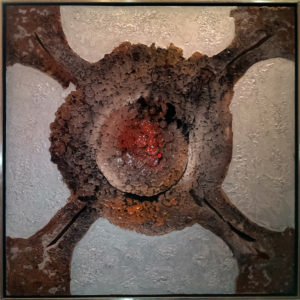
Asher Bilu – Yuga II
In Hindu philosophy Yuga refers to a forming of a time or epoch through a cycle of four stages or seasons and then how this in turn ebbs and flows through the cosmos.
Asher Bilu’s Yuga II from 1966, belongs to a series of four pictures that loosely reference this notion. In the sixties when Yuga II was made, many artists looked to the East and India in particular, as a way of expanding their consciousness. Musicians too, pointedly and publicly tapped the desire to embrace non-western approaches and philosophies resulting in artists as diverse as Yehudi Menuhin and the Beatles collaborating and bringing to the west Indian artists such as sitar master Ravi Shankar.
It was this growing cultural space of the sixties that saw some (but not many) Australian artists embrace the mystical. I think of Lawrence Daw’s Mandalas for example. But Bilu, who arrived in Melbourne from Israel in the late fifties, had already been working seriously within the broader Eurocentric dialogue of process-based abstraction, encouraged by his love of artists such as Paul Klee whose work utilised multi-media. Bilu’s works were focused around such concentrated material experimentation. And it is this intersection in Yuga II, between seeking to expand consciousness, and an artistic methodology pushing out from progressive materialist concerns, that makes this work so intriguing.
When I asked Asher Bilu recently about the actual process of making Yuga II, he cryptically referred to it as being done with water, fire and air. Ultimately however, he revealed that the strangely bubbled and encrusted colourations of Yuga II are the result of a knowing and beautifully uncontrolled collision of silver, casein paint, resin, pigment and yes…..water, fire and air. We see in Yuga II the result of colliding material interactions. We see a suspended chemical aesthetic. We see worlds of creation and destruction. We see the wonderment of the maker.
Jon Cattapan
